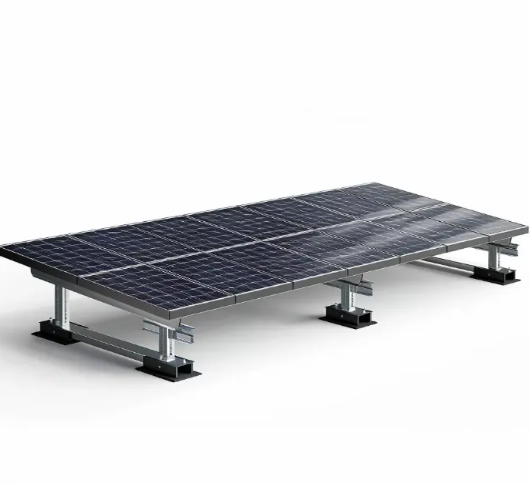Optimal Güneş Paneli Yönelimi ve Verimlilik
Maksimum Güneş Maruz Kalma İçin Yönelimsel Esneklik
Güneş panellerinin açısal konumu, optimal güneş ışığı maruz kalmasına ve dolayısıyla enerji üretimi açısından da bir faktör olarak hayati öneme sahiptir. İlk başta ciddi bir yatırım olsa da, güneş panellerinin tüm yönlerde -doğu, batı, kuzey ve hatta güney- yerleştirilmesiyle gün boyu güneş ışığı toplayabilirler. Bu esneklik, enerji emisyonunu maksimize etmek amacıyla vücuttaki hassas bölgelerde de yerleştirme imkanı sağlar. Gözlemlere göre, güneş panellerinin güneye bakma yörlüğü en fazla güneş ışığı almasını sağlar, özellikle öğle vakti güneşi düşünildiğinde, bu nedenle güneş panelleri için en iyi yönelim budur. Panellerin yatay dizilim yapısı ile güneş ışığının kullanımı maksimize edilebilir ve daha yüksek bir güneş elektrik üretim oranı elde edilebilir.
Çatı Sistemlerine Göre Azaltılmış Gölge Etkisi
Yer tipi sistemlerle, çatı üstü kurulumlarda sıkça karşılaştığımız gölgelenmenin azalması gibi ek bir fayda sağlanır. Güneş panelleri ağaçlar, binalar veya diğer yapıların neden olduğu gölgelerden kaçınacak şekilde stratejik olarak konumlandırılarak yer sistemler enerji üretimi konusunda önemli artışlar sağlayabilir. Yürütülen araştırmalar aslında yerde monte edilmiş panellerin enerji çıkışını çatıya monte edilmiş olanlara kıyasla %20'ye varan oranlarda artırabileceğini göstermektedir. Bu önemli artışın büyük kısmı çatılarda görülen gölgelenme etkilerinin daha düşük olmasından kaynaklanmaktadır ve dolaylı olarak yer tipi kurulumların geleneksel çatı tipi kurulumlardan daha verimli olduğunu doğrulamaktadır.
Sezonel İyileştirmek İçin Ayarlanabilir Eğim Açıları
Zemin monte edilmiş güneş sistemlerinin dikkat çekici özelliklerinden biri, eğim açısının değiştirilebilir olmasıdır; bu da optimal enerji toplamayı karakterize eden akıllı mevsimsel bir değişkenlik sağlar. Eğim açısını değiştirerek bu sistemler her mevsimde etkinliğini büyük ölçüde artırabilirler; kışın kısa günlerinden yazın uzun günlerine kadar. Uzmanlar tarafından önerilen sistemdeki eğim pozisyonunu değiştirmek bazı mevsimlerde yaklaşık %20'luk bir enerji kazancına yol açabilir. Bu esneklik, sadece maksimum güneş potansiyelini kullanmak için optimize edilmiş bir kurulum tasarımı değil, aynı zamanda enerji üretiminin yıllık ve mevsimsel olarak sabit olacağını garanti eden bir pratik çözümdür; bu da zemin üzerine monte edilmiş güneş sistemlerinde ayarlanabilir özelliklerin değerini doğrular.
Basitleştirilmiş Bakım ve İşletme Faydaları
Temizleme ve Onarımlar için Kolay Erişim
Yerdeki güneş enerji sistemleri, camlarınızı temizlemekten daha az sorun yaratmayan temizlik ve bakım açısından kolay erişilebilir olmasından da faydalanır. Bu erişilebilirlik önemlidir çünkü düzenli temizlik, birkaç çalışmanın gösterdiği gibi enerji çıkışı oranını %25 kadar artırabilir. Panellerin erişimi kolay olduğundan, daha düzenli ve kolay bir şekilde bakımlar yapılabilir; bu da panellerin maksimum verimlilik ve çıktı ile çalışmasını sağlayacaktır.
Kar Kaldırma ve Mevsimsel Ayarlamalar
Yer tabanlı foto-voltayik sistemlerin merkezi avantajlarından biri, karın kolayca kaldırılabileceği ve sistemlerin böylece çoğunlukla kış aylarında bile etkin olarak çalışabilecek olmasıdır. Çatı sistemlerinin aksine, kar nedeniyle önemli ışık kaybı yaşayabilirken, yerdeki sistemler karlı koşullarda iyi performans gösterir. Kuzey bölgelerinin verileri de bunu desteklemiştir; kar kaldırma için erişilebilirlik, tüm sezon boyunca yüksek verimle devam eder ve sabit bir üretim sağlar.
Zemin Kurulumlarındaki Uzun Süreli Dayanıklılık
Sert hava koşulları için tasarlanmış, yerdeki sistemler onlarca yıl boyunca dayanmak ve performans göstermek üzere tasarlanmıştır. Uzmanlar göre, yapılar doğru şekilde kurulursa, standart beklentileri uzun süre aşıabilir ve 25 yıldan daha fazla dayanabilir. Bu uzun ömür, daha düşük uzun vadeli bakım maliyetlerine dönüşür ki, bu da yer montajlarının sürekli enerji üretimi için hala iyi bir değer olduğunu gösterir. Dayanıklı yapısı nedeniyle, onlarca yıl sonra bile sürdürülebilir enerji çözümleri konusunda iyi bir yatırım olmaya devam edebilirler.
Çatı Kurulumu Zorluklarını Önleme
Hiçbir Çatı Nüfuzu veya Yapısal Endişe
Zemin monte edilmiş güneş panelleri seçmek, sızıntı veya yapısal hasar gibi çatı montajı risklerini büyük ölçüde azaltabilir. Bu, mevcut evlerinin çatısını bozmak istemeyen ancak güneş enerjisi kullanmak isteyen insanlar için önemli bir konudur. Rast gelecek olursa, 2022 yılında yapılan bir değerlendirme, çatıda güneş sistemi olan ev sahiplerinin %35'inin de sızıntı veya yapısal eksikliklerle karşılaştığını buldu. Tabii ki, bu da zemin monte edilmiş sistemlerin faydalarından biridir - bu potansiyel zorlukları düşünmek zorunda kalmazsınız.
Yaşlı veya Hassas Çatılar ile Uyumluluk
Ayrıca, hassas çatılara sahip daha eski evler için yerde monte edilen güneş sistemleri, mevcut çatı sistemlerinde ek yük ve gerilimi ortadan kaldırarak avantajlı olabilir. Yaşlı Çatılar: Bir Güneş Enerjisi Engeli Artık daha fazla ev sahibi enerji maliyetlerini karşılamak için çatılarına güneş panelleri kuruyor. Ancak birçok vakıanın gösterdiği gibi, yerde monte edilen seçenekleri seçmek insanlara pahalı çatı tamiratları veya değiştirme maliyetlerinden arındırılmış bir şekilde yenilenebilir enerjiye yatırım yapma özgürlüğü tanır ve hem çatıları hem de cebleri korur.
Çatı Değiştirme Çatışmalarını Önleme
Yer monte edilmiş güneş panellerinin başka bir önemli avantajı, çatı değiştirme ortasında kalmaktan endişe duymamanızdır. Ev sahipleri, güneş enerjisi kurulum takvimini çatı dekorasyonları ve tamiratlarıyla uyumlu hale getirmek için zorluk yaşar, bu da potansiyel duruş süreleri ve daha yüksek maliyetler nedeniyle sorun olur. Yaklaşık %40'ın üzerindeki ev sahibinin, bu iki büyük ev iyileştirme projesini koordine etmekle mücadele ettiği tahmin edilmektedir. Bu sorun, yer monte edilmiş sistemlerin kullanılmasıyla önlenir; bu da projeler arasında koordinasyon çatışmalarının ek stresi olmadan kesintisiz bir güneş entegrasyonu sağlar.
Esnek Arsa Kullanımı ve Alan Etkinliği
Kullanılmayan Arazi Alanlarının Kullanılması
Uygun bir güneş enerji çatısı yoksa, yerdeki güneş sistemi çekici bir alternatif sunar. Bu sistemler, çatının montajı desteklememesi durumunda sistemi nereye yerleştirecekleri konusunda bir çözüm sunmak için tasarlanmıştır. Çalışmalar, boş araziyi güneş çiftliklerine dönüştürmenin toprağın daha iyi kullanılmasına ve yenilenebilir enerji çözümleri sağlamasına yardımcı olduğunu göstermiştir. Bu kullanılmayan kapasiteleri kullanarak enerji talebimize çevreye daha dostane bir şekilde cevap verebiliriz.
Çift Amaçlı Kurulumlar (örn., Tarımsal Kullanım)
Yerleşik güneş enerjisinin çok özel bir avantajı, tarla durumlarındaki çift kullanım olanağıdır. Bu kavram, agrivoltaics olarak adlandırılır ve toprak sahiplerine güneş enerjisini yakalamalarını ve aynı zamanda tarım topraklarının kullanımını sürdürmelerini sağlar. Enerji üretimi ve bitki yetiştiriciliği birleştirerek finansal avantaj elde eden çiftçiler gibi birçok örnek bulunmaktadır. Uygun planlama ve uygulama ile hem topraktan ürün verimliliğini sürdürebilir, hem de yenilenebilir bir enerji kaynağı olarak enerji üretebilirler.
Gelecekteki Enerji İhtiyaçları için Ölçeklenebilirlik
Yerde sabitlenen güneş sistemlerinin en önemli özelliği ölçeklenebilirliktir, çünkü sistemler güç tüketiminiz veya teknoloji gereksinimleriniz arttıkça genişletilebilir. Bu esneklik, bize güvenilir, uzun vadede iyi ve dayanıklı bir enerji kaynağı sağlar. Bu açık gün, enerji altyapımızın gelecekteki ölçeklenebilirlik ihtiyacından bahseden endüstri uzmanlarının konuştuğu bir etkinlikti; bu da bizi enerji taleplerini etkili bir şekilde karşılamaya yardımcı oldu. Yer sabitli sistemlerle, geliştiren enerji gerçeğine karşılık gelmek için kapasiteyi parçalara ayırarak artırabiliriz.
Yüksek Enerji Üretimi vs. Kurulum Maliyetleri
Yerdeki güneş enerjili sistemler, kurulum maliyetlerine göre daha fazla enerji verimi sunarak, ekonomik açıdan çekici bir yenilenebilir enerji seçeneği haline gelmektedir. Güneş ışığı alan bölgesinde mümkün olan en verimli açıya göre tasarlanarak, farklı yapılandırmalarda olduğu ile karşılaştırıldığında gelir çok daha erken alınır. Ve önemlisi, yerdeki sistemler çatı birimlerinden %10 ila %15 daha fazla güç üretirler, bu da başlangıçtaki masrafları haklı çıkarıcı olmaktadır. Bu artan üretkenlik kapasitesi, başlangıçtaki kurulum maliyetlerinin çatı sistemlerinden daha pahalı olabileceği olsa da, uzun vadede enerji üretiminde önemli tasarruf sağladıkları başka bir örnektir.
Verimli Tasarım Aracılığıyla Azaltılmış Karbon Ayakizi
Yer tabanlı güneş enerjili güç santralleri, daha iyi dönüşüm verimliliği ve yenilenebilir bir enerji kaynağı kullanarak karbon ayak izlerini önemli ölçüde azaltmaya yardımcı olur. Enerjiyi maksimum seviyede üretme yetenekleriyle ve fosil yakıt bağımlılığını minimuma indirgeme kapasiteleriyle bu sistemler, çevreyi koruma açısından çok önemli bir yer tutar. Çevresel çalışmalar, güneş enerjisine geçişin karbon salınımını %80'a kadar azaltabileceğini göstermektedir, bu nedenle insanlar sisteme yer montajları eklemektedir. Bu yüzden, böyle bir sisteme yatırım yapmak gibi sürdürülebilir bir uygulama, daha temiz bir enerji geleceği doğrultusunda uzun süreli fayda sağlar.
Finansal Teşvikler Yer Monte Sistemler İçin
Güneş destekleri yanı sıra, yerdeki güneş sistemleri için başka finansal teşvikler de bulunmaktadır. Bu teşvikler, vergi indirimleri ve desteklerini içerirken, sakinlerin veya işletmelerin sistemleri kurmak zorunda kaldığı başlangıçtaki harcamayı azaltabilir ve bu da güneş enerjisinin daha uygun hale gelmesine yardımcı olur. Hükümet tahminlerine göre bu teşvikler, güneş sistemi kurulumunun toplam maliyetini %30 kadar düşürebilir ki bu durum daha fazla insan için uygun hale getirir. Ön maliyetleri azaltarak bu ekonomik teşvikler, yerdeki güneş sistemlerinin kurulumlarını daha mantıklı hale getirir ve böylece tüketici çıkarlarıyla sürdürülebilir enerji hedefleri arasında daha iyi bir uyum sağlar.
SSG
Güneş panellerinin hangi yöne bakması en iyidir?
Güneş panellerinin güneye bakması tercih edilir çünkü gün boyunca maksimum güneş ışığı alırlar, özellikle öğle vakti sırasında.
Neden yerde monte edilen güneş sistemleri çatıda yapılan kurulumlardan daha iyidir?
Yerdeki sistemler gölgelemeyi en aza indirir ve ayarlanabilir eğim açıları sağlar, bu da enerji çıkışı üzerinde %20 daha fazla artış sağlayabilir. Ayrıca çatı delmelerini engeller, bu nedenle daha eski veya hassas çatılara uygun hale gelirler.
Boş araziler için yerdeki sistemler nasıl faydalı olabilir?
Boş veya az kullanılan araziyi etkin şekilde kullanır, bu boş alanları üretken güneş enerjisi çiftliklerine dönüştürür ve yenilenebilir enerji çözümlerine katkıda bulunur.
Yerdeki güneş sistemi kurmak için mali teşvikler var mı?
Evet, vergi indirimleri ve iadesi gibi birçok mali teşvik mevcut olup, bu, kuruluştaki maliyetleri %30 kadar düşürebilir.
İçindekiler
- Optimal Güneş Paneli Yönelimi ve Verimlilik
- Basitleştirilmiş Bakım ve İşletme Faydaları
- Çatı Kurulumu Zorluklarını Önleme
- Esnek Arsa Kullanımı ve Alan Etkinliği
- Yüksek Enerji Üretimi vs. Kurulum Maliyetleri
- Verimli Tasarım Aracılığıyla Azaltılmış Karbon Ayakizi
- Finansal Teşvikler Yer Monte Sistemler İçin
- SSG

